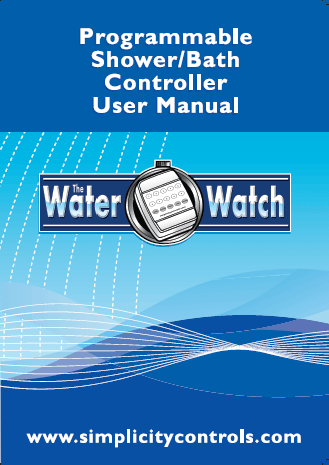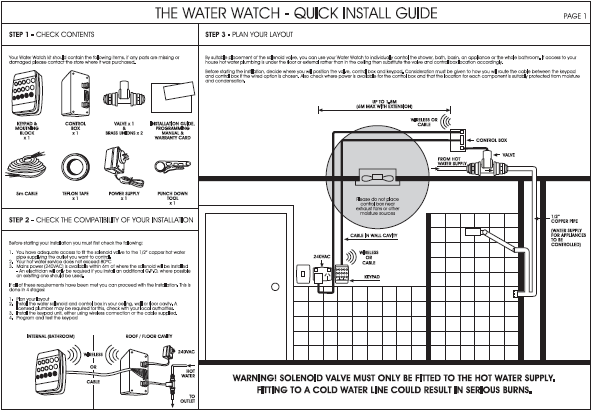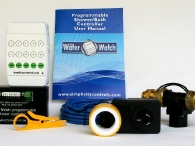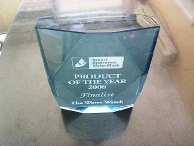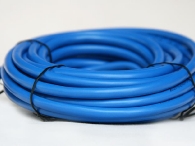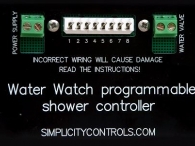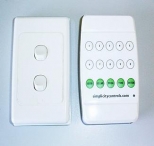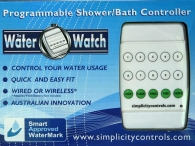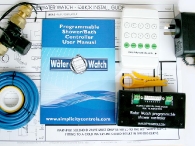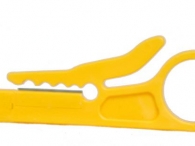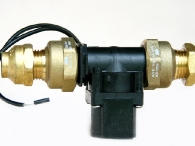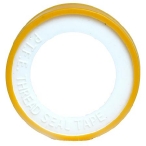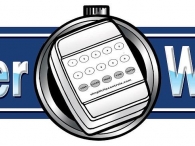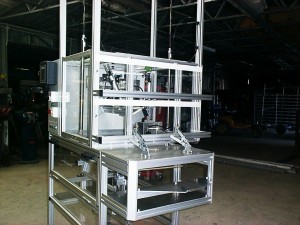Author Archive
We have decided to sell the Water Watch direct from this website. At this time we will not set up an online store as this is the only product we will be selling in this way. Instead, you will need to contact us during business hours on the numbers on the contacts page.
This one off, never to be repeated price, during this special is $150 plus GST of 10% if applicable (Australian residents and businesses) for single units. Freight will be additional and will depend on where you wish the item to be sent to, but usually we could put it in an express post bag for around $12.50. EFT is the only way payment can be made (we email you an invoice) At manufacture the units are packed into foam lined cartons (4 units to a carton). If you get together with your friends and purchase a carton of 4, the price will be $480 plus GST of 10% if applicable. i.e. each separate Water Watch will cost you $120 plus GST
This offer is available for a short time only so don’t procrastinate !!
We look forward to hearing from you soon !
Here is the install guide you would have received with your Water Watch. We are posting it here as there have been requests from purchasers who have lost theirs.
Click on the image to view the Quick Install Guide or “Right Click” and “Save” to download.
Here you will find short, no nonsense, non jargon explanations for any terms used that you may be unfamiliar with. While trying to keep this section as short as possible, we feel it is most important that the terms used are fully understood.
Analogue: This refers to an input usually (or output occasionally) that is a variable. That is such a thing as a temperature reading from a sensor would be an analogue input, because it varies over time.
Application: Applications are specific pieces of software to perform specific tasks. Probably the best known application would be Microsoft Word. SIMplicity is a combination of an application and hardware.
Bus: A name commonly given to what is usually 2 or 3 wires, running around a property, or even wireless, and which carries data. SIMbus is 3 wires, carrying power (24 volts DC + and – and one data wire. A bus with 3 wires allows you to supply low voltage power to sensors, and input and output devices, as well as accept data from them.
Comms Unit: (Communications) This device interfaces between the PC and the bus. With the Simplicity system, it plugs into a USB or serial port on one side and the 3 bus wires on the other.
Device: Anything attached to the bus. See explanations for outputs, inputs and sensors, as well as analogue and digital.
Digital: Digital refers to something that has only 2 states, either on or off. It can apply to both inputs and outputs. For instance we would use a digital output (a relay) to turn on a light or a motor.
Direct Current: Refers to current (electricity) flowing in one direction only, as opposed to AC or alternating current, which actually changes direction at about 50 times a second, depending on which country you are in.
Hard wired: Refers to anything that is permanently wired to a system. In the house high voltage system, the oven for instance would typically be hard wired. A stereo with a plug on the end would not, but the power point it plugs into, would be considered hard wired.
Input: An input can be either analogue or digital and refers to anything that puts information into the system. An analogue input is a variable such as a temperature reading, a digital input is something in one of 2 states e.g. a light switch (low voltage) might be connected to a digital input.
Module: A module is a part which can be added to the base platform. Almost any combination of modules can make up the system. To differentiate between hardware and software, we only refer to software as modules
Multidrop: Multidrop refers to the ability of a bus to have additional devices “dropped” or connected onto it. As long as each device has a different address, devices can be connected up to the limit of the system. Simpler systems are not multidrop, each device needs to be connected to the controller separately.
PCB: Printed Circuit Board. What electronic devices have all their parts mounted on.
Poll: This is what we call when each device is asked for it’s status. For a sensor it may be it’s present reading, for an output, it may be the status of a relay, is it off or on? Each device attached to the bus is “polled” or questioned at preset intervals. With Simplicity 4-6 devices are polled every second, depending on the speed selected for the bus.
Power supply: A power supply is a fancy name for a transformer. essentially this will convert 240 volts AC mains power into 24 volts DC to run the bus. We suggest a couple of 12 volt batteries connected in series to give 24 volts DC should “hang off” the system somewhere, to supply backup during mains failure.
Protocol: The “communications language” that is written to communicate with the devices on the bus.
Output: Output refers to anything that is controlled by the PC or PLC. They are usually digital such as a vent motor or a pump.
Relay: A relay is just a stepping device, to turn something bigger on or off. The relays in our Output Unit are a step up from the switches in the microprocessor heart of the unit. They are big enough to switch something like an irrigation solenoid or LED lighting, but should themselves switch a bigger relay or contractor for high voltage devices.
RF: Stands for Radio Frequency, in short wireless. We use wireless in several devices, because in those devices it is more efficient than wiring. For instance The Water Watch can be either wired or wireless, because it gives more flexibility.
RoHS: Stands for Reduction of Hazardous Substances, mainly lead in the solder used in PCB’s. The electronics industry around the world is slowly moving towards RoHS products.
Simplicity: The first 3 letters stand for Simple Interface for Managers.
Consultancy
After considerable thought and many refused requests Bill Calder has decided to offer a consultancy service to the industry. This consultancy is very specific and limited to the following:
Commercial growing systems only, and
Fancy Lettuce and Herb systems only
Why?: Why would you do this you ask, when everyone else offers consultancy for all crops, all systems in all locations, home and commercial?
It is precisely for this reason that Bill has taken this step. We believe that it is, lets say, extremely difficult if not impossible to be an expert on all commercial crops.
We also find it unusual that most if not all of consultancies offered are from people who are no longer active in the growing side of the industry. We are still active and growing, as is Fancyleaf, after nearly 20 years, and prospective clients can visit us at any time to see our very innovative production methods for this country’s largest supermarket chain.
After being in the industry almost from the beginning, (22 years) we have seen many people enter and quickly exit, due to a variety of reasons. Most are simply very unrealistic expectations of what they expect from the industry. Far too many people we have seen spell hydroponics M-A-G-I-C, forgetting it is simply another way to grow a crop.
Our expertise after this long is in this crop, growing it extremely quickly and using management tools developed by ourselves, such as hydro dosing, a PC based application that will run up to 10 NFT systems, with all nutrient dosing taken care of by the application, and Simplicity growing channel, developed for this particular crop.
If you are thinking of making a substantial investment in a Commercial growing system, you should make the time to talk to one of this industry’s innovators. It will save you money and angst in the long run and could well be the difference between success and failure in the game.
With the rapid introduction of plastic packaging for individual produce items has come a problem, how to get a “best before date” onto slippery plastic sleeves or bags, which are attached to a “wicket”, and no, I don’t have any idea where that name came from.
Like most, if not all primary producers in this position we started with hand activated date coding guns, commonly and mistakenly called pricing guns. This proved to be a very tedious job with orphaned labels all over the area where the job was done and many bags with no stickers due to lack of interest from staff. We made the decision to approach professional machinery makers, who told us the bags were “too slippery” and “too hard to pick up” so we thought we would have a go at the job ourselves.
We knew the control side would be easy for us, and so it proved. Overcoming the other problems were not so easy and it has taken quite some time to get where we are today, with a machine that will do up to 500 sleeves before it needs reloading.
It is that success that allows us to offer our experience for people in a similar position. Fancy lettuce growers, or growers with similar sized bags are now taken care of with a machine they can switch on, walk away and forget, knowing it will stamp the desired number and then stop and wait to be reloaded. If it runs out of bags because of a miscalculation in loading, it will stop with one bag to go.
If you would like us to have a no obligation look at your particular size bag, to see if we can help, we would be happy to do so. We would simply require a carton of your sleeves to be sent to us for evaluation and trialling. If we cannot help you, we will tell you so and all it has cost you is a few sleeves. If we can help, we may require a few more sleeves for further testing, but will be able to give you a pretty fair estimate of the cost involved in a machine to handle your item.
We have moved away from the welded steel frames we were using for prototypes and are now constructing in an aluminium extrusion system that has been developed in Europe especially for this kind of thing. This gives us the ability to be flexible in design from client to client, it is extremely strong and competitively priced.
The system is very quick to assemble, as once design parameters have been set everything comes precut and drilled. Time is also saved as there is no need to paint the finished product. Appearance over time is also improved as there is no paint to scratch or chip, meaning you will have a machine that looks as good as the day it arrived for many years (with minimal care).
We are now also using some Italian air cylinders, which are a little expensive, but again, give us more flexibilty than previously. It also allows the machine to be accessed more easily for loading and unloading.
It is the combination of all of the above that makes us confident we can offer you a solution, so feel free to give us a try!
If you feel we may have the answer to your problem, contact us via this website or leave a comment and we can start a dialouge.
General information
There are several devices on the market to restrict shower use. But they don’t necessarily work. Experience has shown that many people who shower under a rose fitted with a water restricting device, simply stand there twice as long, totally negating any benefit from the device. The Water Watch takes the decision from them, and makes sure they are “done and dusted” in the shortest time possible. Even teenagers who make up a large percentage of the offenders learn to be more careful of water use.
Most people in Australia are aware of our current water shortages and are doing things at a household level. A short stroll through the plumbing section of your local hardware/DIY chain store will always find people in the plumbing section looking for ideas on how to save or reuse water.
That is why we have come up with the Water Watch. We call it that because we feel it is watching over the most valuable resource on the planet, fresh water. With declining water supplies in many areas of the world, including Australia, the world’s driest continent, anything that allows us to stretch the resource should be considered. That is the function of the Water Watch. The benefits of fitting a Water Watch are:
-
An immediate decrease in water consumption
-
An immediate decrease in energy consumption
-
Savings on both energy and water bills
-
Better bathroom utilisation in busy periods.
-
An increased environmental awareness by users
A Water Watch will pay for itself in time, the length of which will depend on your usage, energy and water prices. The more you are using at present, the faster the payback. There is also a less tangible benefit to parents. It seems every family that has children old enough to shower alone has at least one member who is a shower “hog”. This is a source of extreme frustration to parents and can cause unnecessary divisiveness in the family unit, especially in peak usage times. This problem can be totally eliminated, just by the installation of a Water Watch.
Installation is quite easy for a home handy man or woman, although you will have to check the local regulations that apply in your area to see if trades people are required to assist at all. As there are so many possibilities we could not cover them all on this website, but comprehensive installation instructions and ideas are included as part of the kit. You can also glean more information from the install page in this section.
The stand out feature of this device is the ability to program it for individual users, and to be able to change that program easily. Imagine the possibilities for overstaying house guests, or kids that won’t keep their room tidy !
For really hot pricing for a short time, look at the news page.
The Simplicity Date Stamping Machine
The story.
The evolution of this machine has been brought about by necessity. As we also own and run Fancyleaf (see the links bar) which is a South East Queensland Benchmark hydro producer, we had a pressing need to find an answer to the problem of applying a date stamp to the sleeves we pack our Woolworths product into.
It is totally impractical to place this date stamp on the sleeve after the product (fancy lettuce in this case) has been picked, as we have developed picking trolleys for the deployment of the returnable plastic crates we use so as to have them at waist height in front of each picker.
This has meant using what are commonly called checkout guns, or price guns to place a small sticker on each sleeve with a “best before” date on it. The area where this is done (on any farm) invariably becomes covered in orphaned stickers as each gun only holds a roll of 1,000. To reload the gun it is necessary to remove a few stickers from the backing paper first and they get everywhere.
Oh, did I mention how mind numbingly boring this task is? Humans doing this task soon get sick of being careful to stamp each bag, so misses, quite often in large amounts, are inevitable. Â And don’t forget to factor the labour cost of this job into your production costs.
We asked professional machinery builders to look at doing something for us, and the answer came back that it was simply too difficult, or could not be done at all. So, we had to do it ourselves. The result is 2 machines, the label applicating machine and the print directly on the sleeve machine.
The 2 machines are very similar up to a point and it is only a close inspection that reveals the difference. The first machine uses a pneumatic labelling gun and simply mechanises the process. Advantages over a normal gun are label rolls of 5,000 instead of 1,000 and a slightly quicker speed than the higher end model. We have also found no “adhesive bleed” into the gun which seems normal when using by hand. The disadvantages ? Well they are still labels, they still get “lost” sometimes which means all over themachine, plus we have found they don’t want to stick in the middle of winter. Plus the consumable cost is high and ongoing.
The slightly more expensive machine prints the date directly onto the sleeve, doing away with the label altogether, at the cost of being ever so slightly slower than the cheaper model. Consumables for this machine are negligible and easily changed in about 5 seconds, with no messy solvents and inks to worry about.
A medium sized air compressor is required for operation, as well as connection to mains electricity.
DIRECT PRINT MACHINE
The above video is of the direct print machine, the one below is of the machine that prints labels onto the sleeve. After using hand labelling guns and knowing all the dramas that go along with them, why would you bother with labels, it is far better to print the best before date directly onto the sleeve, especially when you don’t need to use expensive and high maintenance inkjet printers.
LABELLING MACHINE
The production model is shown below. It is built using a profile system, has been independently risk assesed and certificated and will give you many years of valuable service.
A sample contract if you wish to view our terms can be found here
|
Simplicty Economical as we call it is the little brother to Simplicity. It is a more basic control system, with inbuilt limitations, but with some astute programming, you can do a surprising amount with it. As the units only accept the older style voltage inputs there are a limited number of sensors available. The heart of the system are mini PLC’s which are quite economical. They will accept some analogue inputs and some digital inputs. There are several models to chose from, with either 10 or 20 I/O’s. |
|||
| The smaller of the two units with 6 inputs and 4 relay (10 amp) outputs | The larger unit with 20 I/O’s including 12 analogue and digital inputs and 8 switched relay outputs. | ||
| Programming is by means of function blocks, which are very easy to learn, especially when you already have a program done for you, and you learn by editing and changing that program. It is as easy as drag and drop. This means you can create exactly the program that fits your application, instead of using something off the shelf that is never exactly right for what you want to do. | |||
| We stock a couple of common environmental sensors such as temperature and humidity, as well as light. These have voltage outputs accepted by the mini PLC’s | |||
|
Temperature and humidity sensor with 0-10 volts DC output. |
Light sensor with the cover removed, again with 0-10 volts DC output. Quite a neat unit for the price. |
||
|
These PLC’s can be networked together using a 485 bus system, which can be set up to give you remote access and some control, but it is mainly for monitoring. Unfortunately each unit cannot “talk” to other units directly, so an output from one unit can be used as an input to another to achieve much the same result. However, for the outlay they are quite good and we have found them extremely reliable so far. |
|||
Simplicity Full Function (see hydro dosing for more info)
Why should I be considering this system?
-
Custom Build We specialise in custom applications that solve your “can’t find exactly what I want dilemma.” We spend the time to get to know your requirements so developing the code is right first time.
-
Flexibility The use of smart sensors will change the world of control in coming years. We have already incorporated the future in our applications. While the world is coming to grips with smart sensors, our hardware partner, Monitor Sensors, has been making them for years.
-
Economy You may well be able to run your custom application from existing hardware, saving you set up costs. No PLC’s are required. Our total costs are among the lowest in the world.
-
Power All Simplicity applications are extremely powerful, and due to the strength of the communications bus used, unbreakable. No reflections or weird happenings from hum and distortion as we have seen on some high speed buses.
-
Access Simplicity applications can be accessed over the internet, from wherever you can find an web connection. You can observe, change and control via the web interface. Alarm interfaces which are user settable will ring your mobile with a spoken message telling you exactly what is not within your set parameters.
-
Sensors A full range of sensors is available that are compatible with the communications bus, robust and affordable. Monitor Sensors have specialised in sensors for agriculture and horticulture for many years.
-
Protection Simplicity applications can have multiple sensors looking at each other and comparing themselves to protect against sensor failure. Any system will eventually have a failed sensor(s) at some time and this will protect against that occurrence. Another small application can simply listen to the sensor “chatter” on the bus and alarm if it stops.is essential for stable, ongoing use, and in the Monibus we believe we have found the best. It certainly is not the fastest in the world, but that is actually its’ strength. And it is fast enough for most applications with 4″ to 6″ sensors being “talked to or polled” every second.
A robust communications bus
System basics: (see glossary for explanation of any terms you do not understand).
The base: Simplicity 2 runs on a software platform or “base”. You need to configure your PC to run Microsoft .NET which is an easy process, then you can install specific Simplicity modules, to your own requirements. All modules share the same base, so adding modules later is very easy. You can upgrade your application at any time your requirements change.
The bus: Simplicity consists of a low voltage wired bus connecting various devices. We use Monibus because of its’ inherent stability. The minimal power required for the bus (as low as 5 volts DC) can come from several sources, the most usual is simply a power supply plugged into the mains electricity grid. The minimum for a system is one comms box and one of the others that follow it below. Plus of course the software “base” and the custom application.
Comms box: The interface between the PC and the bus is done by a communications unit which we call the comms box. This allows the PC to “talk” to the bus using our own protocol. Commands flow through it as the application is working, as well as data from the attached devices coming back to the PC. One side of the comms box is attached to the 3 bus wires, the other to a port on the PC.
Relay box: Full name relay outputs unit. There are 8 separate channels or relays in this unit which can all be independently switched to turn things on and off. Each box and each channel has it’s own address so is unique from the others. Each relay is capable of switching small devices that operate on low power such as solenoids or door strike locks, or switch a larger relay for higher voltage devices. Commands to turn relays on or off are sent down the bus by the comms box, which also will ask the relay box the position of all relays on a regular basis, as a checking mechanism.
Inputs box: Full name inputs unit. Again 8 channels. Basically, when voltage is sensed a LED lights up. This is seen by the micro processor and transmitted as an ON state. The simple explanation for these inputs is that low voltage is taken to a digital switch which is on or off. Low voltage is then taken from the other side of the switch back to the input channel. When the switch is ON that voltage will flow back to the input channel and the state of that channel will be recorded as on. The input box will send any change in status of any of its channels to the application immediately.
Sensors: A full range of environmental and other sensors is offered. All sensors are “µsmart” which means they each have their own micro processor onboard. This means all can be separately addressed and added to the communications bus at any point.
Simplicity Full Function Summary
-
Flexibility using smart sensors allows the whole application able to be more flexible.
-
Sensors We have access to the full range of sensors for any purpose from the one company, all compatible with our applications.
-
Economy Lower install costs, as sensors can be wired to the bus anywhere, they do not have to be wired to an inputs board.
